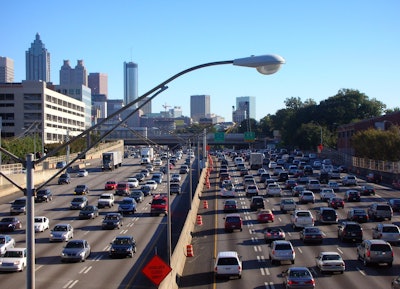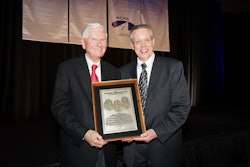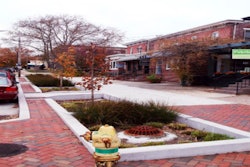 Road work on Interstate 75 heading into Atlanta.
Road work on Interstate 75 heading into Atlanta.The U.S. Department of Transportation (USDOT) has released its “Ladders of Opportunity Transportation Empowerment Pilot LadderSTEP 2015-2016 Report” that shows progress made in seven cities to foster upward mobility through transportation decisions in these areas.
“Transportation projects should be designed and built with the full engagement of communities they impact,” says Transportation Secretary Anthony Foxx. “By partnering with these cities and their mayors in the LadderSTEP pilot program, we were able to take advantage of the tremendous benefits of in-depth collaboration, which has inspired participants to keep creating more opportunities for their communities through transportation projects.”
USDOT launched the LadderSTEP program in 2015 to develop “sustainable economic development related to planned transportation projects.” The seven cities in the pilot include Atlanta; Baltimore; Baton Rouge, Louisiana; Charlotte, North Carolina; Indianapolis; Phoenix; and Richmond, Virginia.
The department worked with each city to select a “game-changing” project, meet with “local stakeholders” to work on the project and discuss the “vision” for them and to determine opportunities for each project. The agency and mayors’ offices also created a “city work plan” for creating a timeline, goals and strategies for the projects.
“Every city that participated in the LadderSTEP program has seen the value of bringing a community together to talk about their area’s future,” says USDOT Chief Opportunities Officer Stephanie Jones. “This pilot showed how the LadderSTEP approach can empower communities across the country to have a collaborative and inclusive process.”
Major accomplishments highlighted in the report include:
- In Atlanta, city and federal staff benefitted by forming new strategic partnerships with local foundations to help stimulate economic development activity in the area. The city chose to focus on the Martin Luther King Jr. Drive Corridor Improvement Initiative, which received a $10 million Transportation Investment Generating Economic Recovery (TIGER) 2016 grant to provide new mobility options and increase access to transit, employment centers, and services. This project will continue to promote the core values of LadderSTEP once the pilot has concluded.
- In Baltimore, significant achievements include helping the city acquire funding for affordable housing on North Pulaski Street; allowing the city to adhere to its local hiring program while using federal funding on the project which employs local residents for construction; and coordinating with the Federal Railroad Administration (FRA) to avoid conflicts with an ongoing FRA project. Additionally, federal-level involvement in the project alleviated private investor concerns about any uncertainty of the project moving forward, which increased developer interest in the area. In West Baltimore, the North Avenue Rising Project received a $10 million TIGER 2016 grant to create a safer corridor along approximately five miles of North Avenue through pedestrian improvements, enhanced bus stops, and transit infrastructure that will increase access to employment centers and essential services for a low-income area continuing the LadderSTEP project area goals.
- In Baton Rouge, the additional federal staff and technical knowledge provided through LadderSTEP enabled the city to complete the TramLinkBR Project’s environmental review process in six months, rather than the typical 12 to 18 months. This environmental assessment is now in the public and agency review process. To help fund construction the city is seeking a Capital Investment Grant (CIG) from the Federal Transit Administration (FTA). Through LadderSTEP, FTA assisted the city in preparing a complete CIG application. On June 24, 2016, the city submitted a request to enter into the project development phase for the fiscal year 2018 CIG program.
- In Charlotte, the city secured $7.7 million in city tax dollars for design work for Phase 2 of the Gold Line Streetcar project and established a partnership with the Knight Foundation, which committed $1.5 million over three years to area revitalization. Furthermore, LadderSTEP served as a platform for bringing all partners together on multiple projects occurring simultaneously to help the city decide how to prioritize these projects.
- In Indianapolis, LadderSTEP support has helped advance the development and pending construction of the city’s first bus rapid transit (BRT) project. The BRT Red Line is planned along the most densely populated corridor in the state and will provide improved transit options for 133,000 college students, 140,000 employees and 60,000 residents who live within a half mile of the line. A large event is planned for 2017 focused on workforce mobility surrounding the BRT Red Line, which will involve new partners that were connected during the pilot. In addition, momentum from LadderSTEP helped Indianapolis successfully pass a ballot initiative for county-wide system improvements and secure a $75 million Small Starts grant from FTA.
- In Phoenix, a TIGER 2014 planning grant funded the development of an environmental assessment (EA) and conceptual engineering for the light rail project. Through LadderSTEP, FTA reviewed the draft EA document and advised the City of Phoenix on necessary edits. The South Central EA was approved for public circulation on May 6, 2016. DOT also organized a workshop, which involved a variety resource groups, included the Ford Foundation that was focused on Equitable Transit Oriented Development (TOD) and hosted a group of 60 community stakeholders who shared their vision for the project. DOT and the Local Initiative Support Corporation also worked with the city to rally community support for a transportation funding referendum, which passed and is contributing funds to the project. The city secured a $700 million transportation infrastructure investment from the Ford Foundation for the Valley Metro light rail extension; began developing an Early Action Business Assistance Program in the corridor; and initiated an application for a FTA TOD planning grant, for which the FTA regional office provided guidance and resources on. Community support for the project has also increased significantly due to a shift in the way city staff are communicating project benefits.
- In Richmond, through LadderSTEP, DOT worked with the city to strategize a redesign of the commercial triangle in the Greater Fulton area and create a zoning and traffic pattern study, as well as a bicycle and pedestrian plan. These efforts have enhanced the transportation network and accelerated the project by providing additional staff resources to communicate with the public and key stakeholders and quickly built connections with other disciplines (e.g., housing). A BRT cooperation agreement is now in place.
The full “Ladders of Opportunity Transportation Empowerment Pilot LadderSTEP 2015-2016 Report” is available here.









